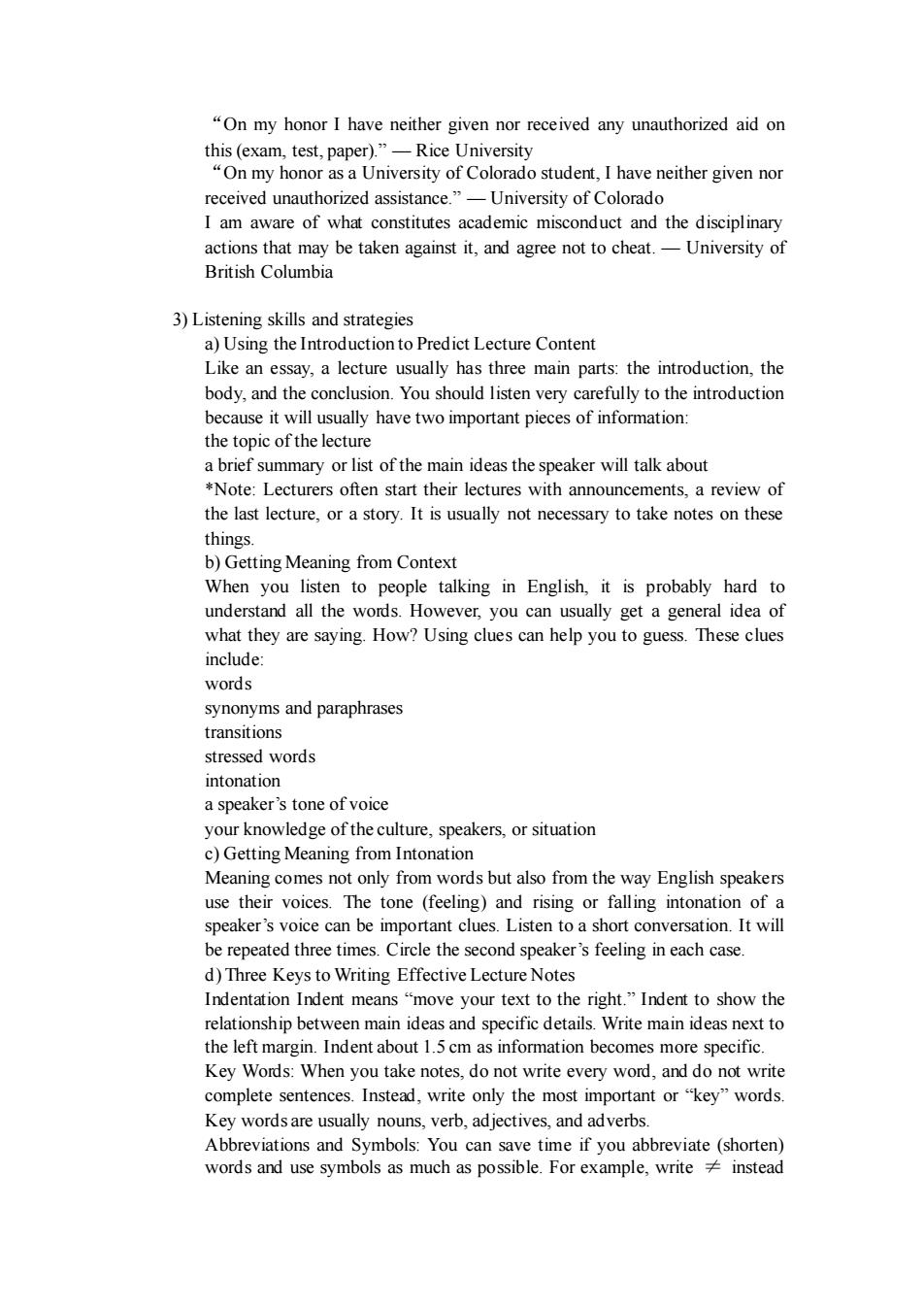正在加载图片...

"On my honor I have neither given nor received any unauthorized aid on nor as a received unauthorized assistance."-University of Colorado I am aware of what constitutes academic misconduct and the disciplinary actions that may be taken against it.and agree not to cheat-University of British columbia 3)Listening skills and strategies a)Using the Introduction to Predict Lecture Content Like an essay,a lecture usually has three main parts:the introduction,the body,and the conclusion.You should listen very carefully to the introduction information: the topic of the lecture a brief summary or list of the main ideas the speaker will talk about *Note:Lecturers often start their lectures with announcements,a review of the last lecture or a story it is usually not necessary to take notes on these When you listen to people talking in English,it is probably hard to understand all the words.However,you can usually get a general idea of what they are saying.How?Using clues can help you to guess.These clues include words synonyms and paraphrases transitions stressed words intonation a speaker's tone of voice your knowledge of the culture,speakers,or situation c)Getting Meaning from Intonation Meaning comes not only from words but also from the way English speakers use their voices The tone (feeling)and rising or falling intonation of a speaker'voe be be repeated three times.Circle the second speaker's feeling in each case d)Three Keys to Writing Effective Lecture Notes Indentation Indent means "move your text to the right."Indent to show the relationship between main ideas and specific details.Write main ideas next to the left margin.Indent about 1.5cm as information becomes more specific. Key Words:Whe ou take notes,do not write very word,and d not w complete sentences.Instead,write only the most important or"key"words Key words are usually nouns,verb,adjectives,and adverbs. Abbreviations and Symbols:You can save time if you abbreviate(shorten) words and use symbols as much as possible.For example,write instead “On my honor I have neither given nor received any unauthorized aid on this (exam, test, paper).” — Rice University “On my honor as a University of Colorado student, I have neither given nor received unauthorized assistance.” — University of Colorado I am aware of what constitutes academic misconduct and the disciplinary actions that may be taken against it, and agree not to cheat. — University of British Columbia 3) Listening skills and strategies a) Using the Introduction to Predict Lecture Content Like an essay, a lecture usually has three main parts: the introduction, the body, and the conclusion. You should listen very carefully to the introduction because it will usually have two important pieces of information: the topic of the lecture a brief summary or list of the main ideas the speaker will talk about *Note: Lecturers often start their lectures with announcements, a review of the last lecture, or a story. It is usually not necessary to take notes on these things. b) Getting Meaning from Context When you listen to people talking in English, it is probably hard to understand all the words. However, you can usually get a general idea of what they are saying. How? Using clues can help you to guess. These clues include: words synonyms and paraphrases transitions stressed words intonation a speaker’s tone of voice your knowledge of the culture, speakers, or situation c) Getting Meaning from Intonation Meaning comes not only from words but also from the way English speakers use their voices. The tone (feeling) and rising or falling intonation of a speaker’s voice can be important clues. Listen to a short conversation. It will be repeated three times. Circle the second speaker’s feeling in each case. d) Three Keys to Writing Effective Lecture Notes Indentation Indent means “move your text to the right.” Indent to show the relationship between main ideas and specific details. Write main ideas next to the left margin. Indent about 1.5 cm as information becomes more specific. Key Words: When you take notes, do not write every word, and do not write complete sentences. Instead, write only the most important or “key” words. Key words are usually nouns, verb, adjectives, and adverbs. Abbreviations and Symbols: You can save time if you abbreviate (shorten) words and use symbols as much as possible. For example, write ≠ instead